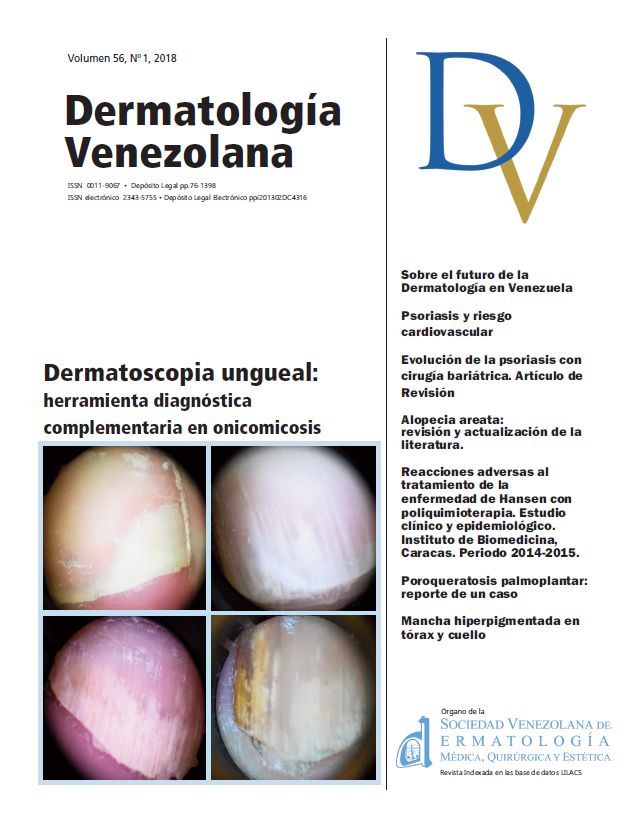Reacciones adversas al tratamiento de la enfermedad de Hansen con poliquimioterapia. Estudio clínico y epidemiológico. Instituto de Biomedicina, Caracas. Periodo 2014-2015.
Palabras clave:
Enfermedad de Hansen, poliquimioterapia, dapsona, reacción adversa, anemia.Resumen
La lepra es una enfermedad granulomatosa crónica causada por el Mycobacterium leprae y lepromatosis, que afecta principalmente la piel y los nervios periféricos. La OMS proporciona gratuitamente a los enfermos el tratamiento de poliquimioterapia el cual consta de: rifampicina y dapsona que constituyen el esquema paucibacilar, al cual se le adiciona la clofazimina en pacientes multibacilares. Existen pocos estudios en la literatura acerca de los efectos adversos a esta
poliquimioterapia. OBJETIVO: Determinar las reacciones adversas a la poliquimioterapia para enfermedad de Hansen en la consulta de dermatología del Instituto de Biomedicina, en el período entre agosto 2014 y agosto 2015. MATERIALES Y MÉTODOS: se realizó un estudio epidemiológico retrospectivo, descriptivo, de revisión de historias médicas. Se investigaron efectos adversos a la poliquimioterapia clásica. RESULTADOS: del total de 121 pacientes, 29 presentaron efectos adversos
(23.9%) predominando en el sexo femenino. El grupo etario más afectado fueron los adultos entre 14 y 35 años (33%), la forma clínica más frecuente fue el Hansen BB (44.44%) seguido del BL (40.91%). Los principales efectos adversos evidenciados fueron: anemia, cefalea y trastorno hepático, siendo el más frecuente la anemia con un 11% y el agente responsable de esta, la dapsona en un 100% de los casos. CONCLUSION: Los eventos adversos a la poliquimioterapia fueron encontrados en mayor porcentaje a los reportados por la OMS, siendo frecuentemente subdiagnosticados durante el tratamiento de la enfermedad de Hansen.
Adverse polychemotherapy reactions in patients with Hansen's
disease. Epidemiological and clinical study. Caracas, “Instituto de Biomedicina”. Period 2014-2015.
Summary:
Leprosy is a chronic granulomatous disease caused by Mycobacterium leprae and lepromatosis that affects mainly the skin and peripheral nerves. WHO provides free of charge to all patients treatment of multidrug therapy which consists of the following drugs: dapsone and rifampicin constituting the paucibacillary scheme, to which is added clofazimine in multibacillary patients. There are few studies in the literature on the adverse effects of this combination chemotherapy. OBJECTIVE: To determine the adverse reactions to polychemotherapy in Hansen’s disease among patients attending the dermatology clinic center, Institute of Biomedicine, from August 2014 to August 2015. MATERIALS AND METHODS: A retrospective, descriptive, epidemiological study reviewing medical records. In them, classic polychemotherapy adverse effects were investigated. RESULTS: A total of 121 patients, 29 had adverse effects (23.9%) predominantly female, the age group most affected were adults between 14 and 35 years (33%), most common clinical form was the Hansen BB (44.44%) followed by BL (40.91%). Main adverse effects evidenced were anemia, headache and liver disorder, the most frequent was anemia with 11% and the agent responsible of this dapsone 100% of cases. CONCLUSION: polychemotherapy adverse events were found in a higher percentage than those reported by WHO, constituting these, often undiagnosed events during the treatment of Hansen's disease.
Key words: Hansen’s disease, polychemotherapy, dapsone, adverse reactions, anemia.
Descargas
Número
Sección
Licencia
Publicado por la Sociedad Venezolana de Dermatología Médica, Quirúrgica y Estética







